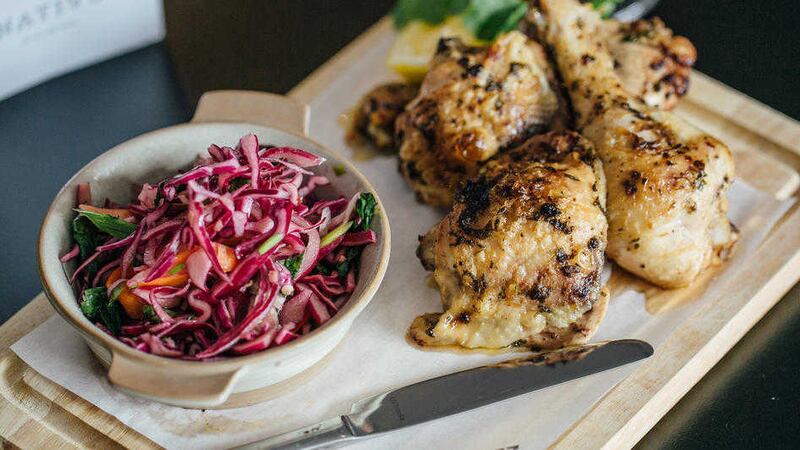URBAN agriculture… low food miles… food sustainability… they’re all buzzwords for the growing trend to bring fresh food back to its roots.
Restaurants are already catching on to the idea with the establishment of kitchen gardens to supply their chefs with a ready supply of ultra-fresh herbs, salad leaves and edible flowers. Visit St Anne’s Square in Belfast’s fashionable Cathedral Quarter and you’ll find a walled garden of greenery (all-be-it at knee level), with planters strategically stationed facing each other outside most of the restaurants.
One of the pioneers of this ‘grow-it-yourself’ phenomenon is Native, the Yellow Door Group’s latest restaurant, located in the MAC arts venue at St Anne’s Square.
“Our kitchen gardens are very much in line with our sustainable sourcing policy and the quest for the very best and freshest flavours,” said general manager Phil Rodgers.
“We have installed planters not only at the front of the restaurant but also on a first floor balcony and on the roof top of the building. The produce we are able to grow is quite simply miles ahead in terms of taste and freshness, and our head chef loves the fact that he has such a wide variety of produce available for a good part of the year to give his dishes an extra depth of flavour.”
At its most basic, urban agriculture requires only a small container, compost, some interesting edibles and the patience to wait until your young shoots have grown to their full potential before despatching them to the kitchen.
A small back yard, a convenient rooftop or a window sill is sufficient to start your own kitchen garden, and even with this modest ‘small holding’ you can grow an interesting variety of herbs to give you a ready supply, 12 months of the year, right where you want them, when you need them.
But the wider choice of produce you can grow is itself mouthwatering – as well as the more usual varieties of herbs, you can grow baby or micro herbs, salad leaves, edible flowers and unusual hardy annuals – anything that tickles your fancy really.
And the best part is that the taste will be so super fresh that you won’t want to go back to buying imported produce that by its very nature must suffer to some degree in terms of freshness, flavour and shelf-life.
SAGE ADVICE
The addition of fresh herbs can take a dish to a whole new level of flavour, and for outdoor planting at this time of year, it’s best to choose hardier varieties that are more robust and able to withstand the autumnal temperature drop.
Native’s chef, Barry Heaton, recommends rosemary, sage, thyme, mint and oregano.
“They’re also suitable to grow indoors where sunlight is available,” says Barry, “and other herbs such as basil, parsley and coriander are also great for an indoor windowsill as they are more suited to warmer indoor conditions.
“Containers are great to grow your produce in as they can be moved indoors when the weather gets bad.”
GO POTTY
The aesthetics of the growing environment can enhance your outdoor space to reflect your personality and add interest to the drabbest of back yards. Growing containers can be recycled, bought or made, but advice from the Belfast Food Network (which has produced a handy edible gardening toolkit aimed at restaurants but just as useful for the home chef too and available as an e-book at www.belfastfoodnetwork.org) is that they must have drainage holes put in the bottom. If they don’t, you need to make some with a screwdriver or drill.
The larger the container the better; very small pots or containers need too much attention as regards watering and feeding and your plants will struggle.
Preparing a nice bed for your new plants is also important – soil-based composts mixed with multi-purpose or potting compost is best, along with a little horticultural grit for hardy herbs. Add a top dressing of compost in autumn and spring and a scattering of organic pelleted chicken manure.
All that remains is to let nature do its work.
:: Try these recipes from Native chef Barry Heaton for dishes using herbs from the Native kitchen gardens.
CREAM OF ONION AND ROSEMARY SOUP
3 white onions, peeled and sliced
3 sprigs of rosemary, leaves picked and chopped
1 medium sized potato, peeled and sliced
1ltr of chicken or vegetable stock
2 tbsp olive oil
salt and pepper
In a saucepan, heat oil to a medium heat and gently fry onions until golden. Add chopped rosemary and sliced potatoes, season with salt and pepper, add stock and bring to the boil. Reduce the heat to low, cover with a lid and simmer for 15-20 minutes. Remove from heat, allow to cool slightly, add cream and blend until smooth. Serve with warm crusty bread.
NATIVE CORIANDER AND LEMON CHICKEN
1kg chicken thighs and drumsticks
50g chopped coriander
4 cloves garlic (minced)
juice of 1 large lemon
1 tsp of ground cumin
1 tsp of sweet paprika
½ tbsp of olive oil
salt and pepper
Combine the lemon juice, coriander, ginger, cumin, garlic and oil in a bowl and add the chicken pieces. Season well, coating them in the marinade. Allow to marinate in a fridge for 2 hours.
Pre-heat oven to 180C. Place the marinated chicken, skin side up in a baking dish and cover with foil. Cook for 20 minutes on skin side and 10-15 minutes on flesh side until fully cooked. Serve with all the juices.






